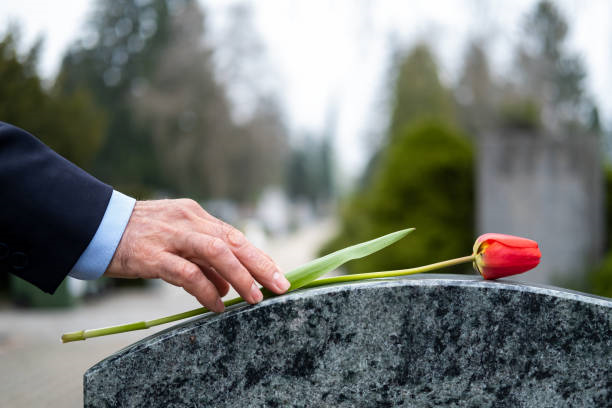Eco-Friendly Options for Headstone Monuments

Many aspects of our lives, including funeral customs, have an impact on the environment. While it may not be something that many people consider, the importance of sustainability and eco-friendliness has gained international recognition. Traditional headstone monuments often utilize harmful materials that are not sustainable. However, there are environmentally friendly alternatives available that have made it easier to honor our loved ones while also respecting the environment.
What are Headstone Monuments?
Headstones, often called tombstones, are upright markers placed at a deceased person’s cemetery to honor and remember their life. Usually, these monuments are composed of a slab or tablet set on a base or pedestal composed of strong substances like concrete, metal, or stone (granite, marble, slate, etc.). The name, birth, and death dates, sometimes memorials or other meaningful words honoring the departed, are written on headstone monuments.
Eco-Friendly Headstone Monument Options
The Natural Stone
Granite
Granite is a popular option because of its weather adaptability, variety of colors, and durability. It is made of a solid, hard substance that is perfect for outdoor use as a result of the slow crystallization of molten rock that occurs far below Earth’s surface.
Marble
Heat and pressure cause limestone to change into marble, which is admired for its beautiful texture and graceful appearance. Because of its everlasting beauty, marble is frequently chosen above other materials for headstone monuments despite being softer than granite and more prone to erosion and scratches over time.
Slate
Clay particles, mica, and quartz make up the majority of slate, which was created over millions of years by crushing sandstone layers. Because of its low porosity and solid composition, which prevent water absorption and damage, it is ideal for outdoor applications such as headstone monuments. Slate can be modified with a variety of colors, including gray, blue, green, black, and purple.
Sandstone
Sandstone is a sedimentary rock. With its rough texture and range of colors, including brown, red, yellow, and beige, it gives monuments a touch of warmth and personality. Because sandstone resists weathering and erosion, it can be used outside in a variety of conditions.
Wood
For environmentally friendly headstone monuments, sustainable wood options like bamboo, recovered wood, or certified hardwoods like oak or cedar are great options. Wood is a biodegradable material that may be carved or engraved with complex designs to create a unique memorial that blends in with the surrounding environment.
Living Memorials
A living memorial is the one that grows and changes over time. This includes trees, bushes, or flowers that are planted in honor of a loved one. They not only look beautiful but also provide shade over the grave. Over the years, as the plants grow and the landscape changes, the living memorial serves as a lasting tribute. This natural cycle symbolizes life and the continuation of memory.
Biodegradable Materials
Alternatives to traditional headstone monuments are more environmentally friendly and include headstones made from biodegradable materials like cardboard, recycled paper, or bioplastics. Without releasing dangerous chemicals or contaminants into the environment, these materials degrade organically.
Natural Burial Markers
In natural burial grounds, native stones, boulders, or carved rocks act as quiet yet important memorials. These organic components support the preservation of local ecosystems while blending in well with the surroundings.
Ceramic Memorials
Since ceramics are naturally non-toxic and inert, there is little risk to the environment or public health. Ceramic headstones are stable and secure for the duration of their existence, in contrast to some materials that may slowly leak dangerous substances or other contaminants.
Recycled Glass
Choosing recycled glass to build headstone monuments is a beautiful and eco-friendly way to honor loved ones. Made from upcycled glass, these unique monuments are not just good for the planet by reducing landfill waste, but they also bring a distinctive beauty to each memorial. Thanks to their durability and resistance to the elements, these headstones stand the test of time and can be customized to suit personal preferences.
Inks and Engraving
When it comes to eco-friendly monuments, it’s not just about the materials that are used to make these headstones. This also includes the ink or engraving process people use. It is important to use engraving methods that are sustainable. For example, lately, people are opting for laser engraving as it stands out for its energy efficiency and minimal chemical use. This option reduces the carbon footprint associated with traditional engraving processes. You can also use natural inks derived from plants or water-based sources as they are non-toxic.
Wrap Up
There are many environmentally friendly headstone monuments solutions available for cemeteries. It’s time to understand that just as it’s important to pay lasting honor to our loved ones, it’s also important to protect our climate. Therefore, the best practice is to use sustainable inks and materials to keep your burial practices green.
Contact us now to create headstone memorials that honor your loved ones.
Many aspects of our lives, including funeral customs, have an impact on the environment. While it may not be something that many people consider, the importance of sustainability and eco-friendliness has gained international recognition. Traditional headstone monuments often utilize harmful materials that are not sustainable. However, there are environmentally friendly alternatives available that have made it easier to honor our loved ones while also respecting the environment.
What are Headstone Monuments?
Headstones, often called tombstones, are upright markers placed at a deceased person’s cemetery to honor and remember their life. Usually, these monuments are composed of a slab or tablet set on a base or pedestal composed of strong substances like concrete, metal, or stone (granite, marble, slate, etc.). The name, birth, and death dates, sometimes memorials or other meaningful words honoring the departed, are written on headstone monuments.
Eco-Friendly Headstone Monument Options
The Natural Stone
Granite
Granite is a popular option because of its weather adaptability, variety of colors, and durability. It is made of a solid, hard substance that is perfect for outdoor use as a result of the slow crystallization of molten rock that occurs far below Earth’s surface.
Marble
Heat and pressure cause limestone to change into marble, which is admired for its beautiful texture and graceful appearance. Because of its everlasting beauty, marble is frequently chosen above other materials for headstone monuments despite being softer than granite and more prone to erosion and scratches over time.
Slate
Clay particles, mica, and quartz make up the majority of slate, which was created over millions of years by crushing sandstone layers. Because of its low porosity and solid composition, which prevent water absorption and damage, it is ideal for outdoor applications such as headstone monuments. Slate can be modified with a variety of colors, including gray, blue, green, black, and purple.
Sandstone
Sandstone is a sedimentary rock. With its rough texture and range of colors, including brown, red, yellow, and beige, it gives monuments a touch of warmth and personality. Because sandstone resists weathering and erosion, it can be used outside in a variety of conditions.
Wood
For environmentally friendly headstone monuments, sustainable wood options like bamboo, recovered wood, or certified hardwoods like oak or cedar are great options. Wood is a biodegradable material that may be carved or engraved with complex designs to create a unique memorial that blends in with the surrounding environment.
Living Memorials
A living memorial is the one that grows and changes over time. This includes trees, bushes, or flowers that are planted in honor of a loved one. They not only look beautiful but also provide shade over the grave. Over the years, as the plants grow and the landscape changes, the living memorial serves as a lasting tribute. This natural cycle symbolizes life and the continuation of memory.
Biodegradable Materials
Alternatives to traditional headstone monuments are more environmentally friendly and include headstones made from biodegradable materials like cardboard, recycled paper, or bioplastics. Without releasing dangerous chemicals or contaminants into the environment, these materials degrade organically.
Natural Burial Markers
In natural burial grounds, native stones, boulders, or carved rocks act as quiet yet important memorials. These organic components support the preservation of local ecosystems while blending in well with the surroundings.
Ceramic Memorials
Since ceramics are naturally non-toxic and inert, there is little risk to the environment or public health. Ceramic headstones are stable and secure for the duration of their existence, in contrast to some materials that may slowly leak dangerous substances or other contaminants.
Recycled Glass
Choosing recycled glass to build headstone monuments is a beautiful and eco-friendly way to honor loved ones. Made from upcycled glass, these unique monuments are not just good for the planet by reducing landfill waste, but they also bring a distinctive beauty to each memorial. Thanks to their durability and resistance to the elements, these headstones stand the test of time and can be customized to suit personal preferences.
Inks and Engraving
When it comes to eco-friendly monuments, it’s not just about the materials that are used to make these headstones. This also includes the ink or engraving process people use. It is important to use engraving methods that are sustainable. For example, lately, people are opting for laser engraving as it stands out for its energy efficiency and minimal chemical use. This option reduces the carbon footprint associated with traditional engraving processes. You can also use natural inks derived from plants or water-based sources as they are non-toxic.
Wrap Up
There are many environmentally friendly headstone monuments solutions available for cemeteries. It’s time to understand that just as it’s important to pay lasting honor to our loved ones, it’s also important to protect our climate. Therefore, the best practice is to use sustainable inks and materials to keep your burial practices green.
Contact us now to create headstone memorials that honor your loved ones.
